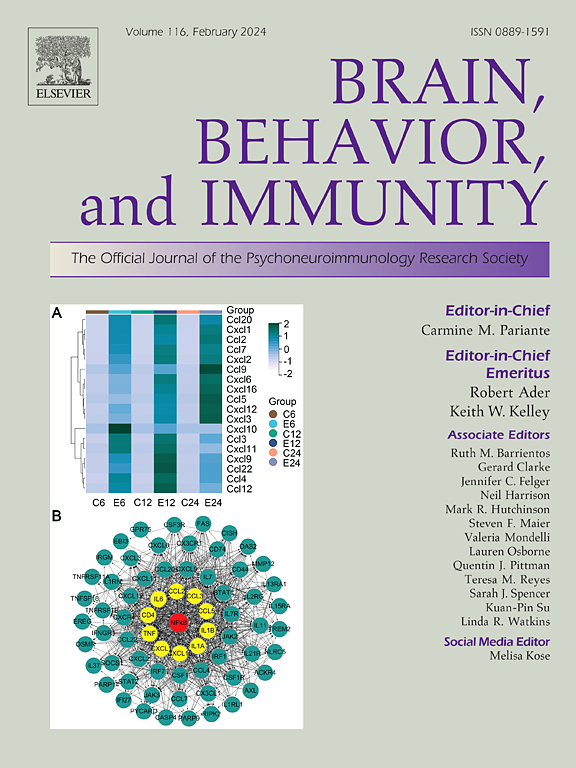慢性疼痛患者脑脊液CCL25与疲劳呈负相关。
IF 8.8
2区 医学
Q1 IMMUNOLOGY
引用次数: 0
摘要
背景和目的:慢性疼痛常伴有其他症状,如疲劳和睡眠障碍,这些症状都与神经免疫激活有关。然而,它们在神经免疫轴上的相互关系仍然难以捉摸。根据最近的一项综述,与对照组相比,慢性疼痛患者的脑脊液(CSF)中的细胞因子似乎普遍上调,而不考虑疼痛类型。其中一些有可能改变血脑屏障(BBB)的渗透性。因此,在一组患有退行性椎间盘疾病(DDD)、腰椎间盘突出(LDH)或骨关节炎(OA)的患者中,测量了血清和CSF中的细胞因子水平以及血脑屏障通透性。在这项探索性研究中,我们对血清或脑脊液中的细胞因子是否与睡眠障碍或疲劳相关感兴趣,特别考虑了血脑屏障通透性的影响,以及这些细胞因子之间是否可以发现功能簇。方法:选取120例等待手术的DDD/LDH/OA患者。手术当天采集血液和脑脊液。疼痛采用视觉模拟量表0-100 mm测量,睡眠障碍采用匹兹堡睡眠质量指数评估,疲劳采用多维疲劳量表(MFI)测量。使用瑞典OLINK公司的92蛋白复合面板分别分析血清和脑脊液中细胞因子的表达。采用ELISA法测定csf -血清白蛋白商。采用非参数统计进行单因素分析,假发现率(FDR) 主要结果:血脑屏障通透性与血清-CSF动力学相关:31种细胞因子与CSF-血清显著相关,血脑屏障通透性与35种细胞因子的商和11种细胞因子的CSF水平显著相关。一些细胞因子与休息时疼痛和全身疲劳负相关。睡眠障碍和细胞因子之间没有相关性。与疲劳相关的血清和脑脊液细胞因子的网络分析揭示了两个隔室的功能簇。休息时的焦虑、抑郁和疼痛是睡眠障碍的重要回归因子,R2 = 0.41。除了休息时的抑郁和疼痛外,CCL25的CSF水平是一般疲劳的显著回归因子,R2 = 0.47。讨论和结论:在这项对等待手术的慢性疼痛队列免疫谱的探索性研究中,强调了血脑屏障动力学对血清- csf细胞因子动力学的重要性,以及在较小程度上对细胞因子中枢水平的重要性。令人惊讶的是,血清或脑脊液中的任何细胞因子与睡眠障碍之间没有关联,尽管临床上明显的睡眠障碍非常普遍。相反,一般疲劳与血清和脑脊液中细胞因子水平之间存在一些关联。值得注意的细胞因子是CSF中的CXCL11和CCL25,特别是因为它们的直接功能关联。在动物模型中发现CXCL11具有神经保护作用,而CCL25被认为是一种促炎细胞因子,是唯一一种对疲劳程度有显著负面影响的细胞因子。虽然因果关系无法解决,但在单变量和多变量分析中,CCL25与疲劳之间的负相关表明,神经免疫活动可能对疲劳程度有改善作用。这项研究进一步增加了现有的证据,即中枢作用的细胞因子与症状的严重程度有关,疼痛和疲劳似乎有轻微不同的细胞因子谱。睡眠障碍需要进一步解决,理想情况下使用主观和客观的评估方法。CCL25和CXCL11是未来研究疼痛及相关症状的有趣生物标志物。本文章由计算机程序翻译,如有差异,请以英文原文为准。
CCL25 in the cerebrospinal fluid is negatively correlated with fatigue in chronic pain patients
Background and aim
Chronic pain is often accompanied by other symptoms such as fatigue and sleep disturbance, and these symptoms all correlate with neuroimmune activation. However, their relation to one another on a neuroimmune axis remains elusive. Based on a recent review, cytokines in the cerebrospinal fluid (CSF) seem to be generally upregulated in patients with chronic pain compared to controls, disregarding pain type. Some of these have the possilibity of altering blood–brain barrier (BBB) permeability. Therefore, cytokine levels in serum and CSF, as well as BBB permeability, were measured in a cohort of patients suffering from either degenerative disc disease (DDD), lumbar disc herniation (LDH) or osteoarthritis (OA). In this exploratory study, we were interested in whether cytokines in the serum or CSF are associated with sleep disturbance or fatigue, with special consideration of the effect of BBB permeability, and whether functional clusters can be found among these cytokines.
Method
One-hundred-twenty patients with DDD/LDH/OA, all awaiting surgery, were included. Blood and CSF were collected on the day of surgery. Pain was measured with a visual analog scale 0–100 mm, sleep disturbance was assessed using Pittsburgh Sleep Quality Index (PSQI), and fatigue was measured using the Multidimensional Fatigue Inventory (MFI). A 92-protein multiplex panel (OLINK, Sweden) was used to analyze cytokine expression in serum and CSF, respectively. CSF-serum albumin quotient was measured using ELISA. Non-parametric statistics were used for univariate analyses, and a false discovery rate (FDR) < 0.10 was considered statistically significant. Bonferroni correction was applied to all multivariable protein analyses to obtain conservative effect estimates.
Main results
There was an association between BBB permeability and serum-CSF dynamics: thirty-one cytokines showed significant CSF-serum correlation, and BBB permeability was significantly correlated to the quotients of 35 cytokines and to the CSF levels of 11 cytokines. Several cytokines were negatively correlated to both pain at rest and general fatigue. No correlations were found between sleep disturbance and cytokines. Network analyses of serum and CSF cytokines that were correlated with fatigue revealed functional clusters in both compartments. Anxiety, depression, and pain during rest were important regressors for sleep disturbance with an R2 = 0.41. In addition to depression and pain during rest, CSF levels of CCL25 was a significant regressor regarding general fatigue, with an R2 = 0.47.
Discussion and conclusion
In this exploratory study of immune profiles in chronic pain cohorts awaiting surgery, the importance of BBB dynamics on serum-CSF cytokine dynamics, and to a lesser extent on central levels of cytokines, is highlighted. Surprisingly, there were no associations between any cytokines in serum or CSF and sleep disturbance, despite a high prevalence of clinically significantly disturbed sleep. In contrast, several associations between general fatigue and cytokine levels in both serum and CSF were found. Cytokines of note are CXCL11 and CCL25 in the CSF, especially because of their direct functional association. CXCL11 has been found to exert neuroprotective effects in animal models, while CCL25 is known as a proinflammatory cytokine and is the only cytokine to fall out as a significant negative contributor to degree of fatigue. While causality cannot be addressed, the negative correlation between CCL25 and fatigue in both univariate and multivariate analyses implies that neuroimmune activity might have an ameliorating effect on the degree of fatigue.
This study further adds to existing evidence that centrally acting cytokines are associated with severity of symptomatology, and highlights that pain and fatigue seem to have slightly different cytokine profiles. Sleep disturbance needs to be further addressed, ideally using both subjective and objective assessment methods. CCL25 and CXCL11 are interesting biomarkers for future research on pain and associated symptoms.
求助全文
通过发布文献求助,成功后即可免费获取论文全文。
去求助
来源期刊
CiteScore
29.60
自引率
2.00%
发文量
290
审稿时长
28 days
期刊介绍:
Established in 1987, Brain, Behavior, and Immunity proudly serves as the official journal of the Psychoneuroimmunology Research Society (PNIRS). This pioneering journal is dedicated to publishing peer-reviewed basic, experimental, and clinical studies that explore the intricate interactions among behavioral, neural, endocrine, and immune systems in both humans and animals.
As an international and interdisciplinary platform, Brain, Behavior, and Immunity focuses on original research spanning neuroscience, immunology, integrative physiology, behavioral biology, psychiatry, psychology, and clinical medicine. The journal is inclusive of research conducted at various levels, including molecular, cellular, social, and whole organism perspectives. With a commitment to efficiency, the journal facilitates online submission and review, ensuring timely publication of experimental results. Manuscripts typically undergo peer review and are returned to authors within 30 days of submission. It's worth noting that Brain, Behavior, and Immunity, published eight times a year, does not impose submission fees or page charges, fostering an open and accessible platform for scientific discourse.

 求助内容:
求助内容: 应助结果提醒方式:
应助结果提醒方式:


